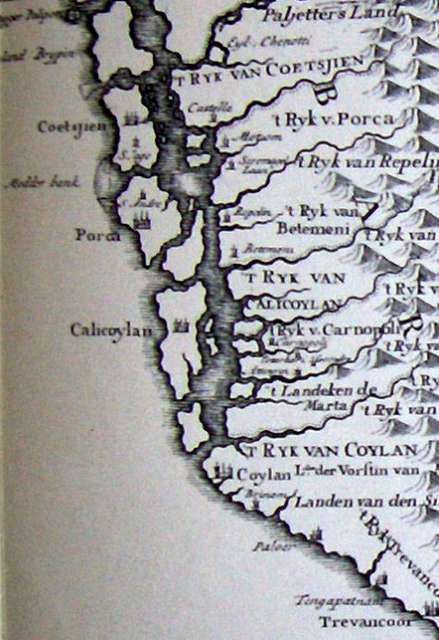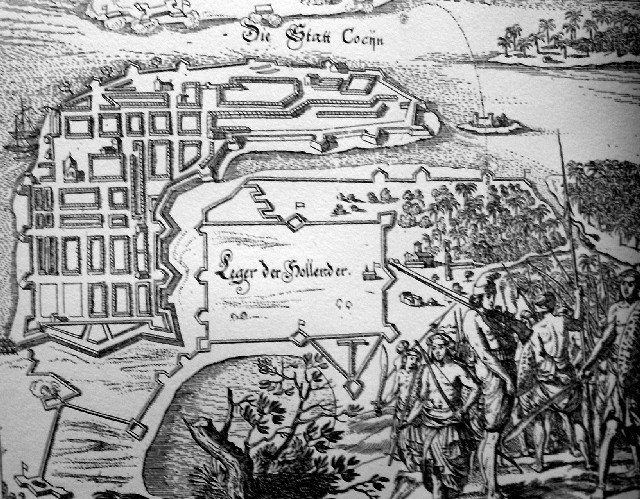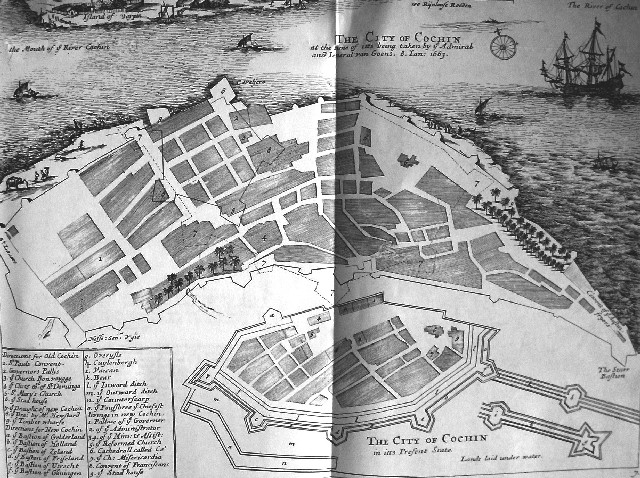The second siege of Cochin
In the first days of July 1662, while Huibert de Lairesse was slowly making his way towards the Cape, news of the extra fleet and the postponed peace reached the Hoge Regering in Batavia. Van Goens, who had arrived back in Batavia only two weeks earlier, would be getting another chance at conquering Cochin, and would perhaps even find time and resources to undertake something against Diu. A small fleet of three ships, manned with some 300 soldiers under command of Ijsbrand Godske, was sent out on the 26th of July, in order to block Cochin, and take command of the Dutch garrisons on the coast to form a field army. Learning lessons from the failure of the earlier campaign, the Hoge Regering also instructed Godske to have the Dutch garrisons in Malabar produce fuses, and sent out a huge order for gunpowder to the Coromandel Coast, where the Company had a powder mill. The rest of the fleet would be sent after Godske as soon as it had been assembled.[1]
By the end of August, the fleet, consisting of thirteen large ships manned with 800 European soldiers and 134 Mardijkers, Bandanese and Ambonese, was ready to sail. The Hoge Regering reckoned that the total force, consisting of this fleet combined with soldiers drawn from the Ceylonese and Malabar garrisons and even 150 which would have to come from the Cape, would amount to a good 3000 soldiers. This calculation did not even include the extra fleet coming in from Patria. Disappointed by the late arrival of last year’s extra fleet, combined with the poor quality of the soldiers it brought, the Hoge Regering was apparently not getting its hopes up this time.
The fleet set sail on the 26th of August. As Van Goens was severely ill at the time, Jacob Hustaert was in command. Should Van Goens recover, he would come after the fleet and retake command later. Van Goens, did recover, and went in pursuit of the main fleet on the 10th of September, with one ship and a yacht. He received additional orders to sail to Wingurla in Bijapur, north of Goa, to inform there whether any reinforcements had run into Goa that year. On the basis of that information, it would then have to be decided whether Goa should be blocked, to prevent these reinforcements from sailing out to Cochin.
As Van Goens departed from Batavia, Godske, after a very speedy journey, arrived before Cranganore on that same 10th of September. He presently learned that only three small ships, bringing 100 Portuguese soldiers, had come into Cochin in the past few months. Combining the troops from his fleet with a good part of the Cranganore garrison, he marched towards the northside of Cochin, and had the Dutch stronghold built last year, Nieuw Oranje, restored by the 24th of September.
Hustaert arrived before Cochin on the 17th of October. He immediately called together the military council. His own suggestion, inspired by Van Goens’ original plan, was to just have a storm attack on the city and get it over with, but all the other officers thought this too risky. An attack on the city from the north, over the river, was considered too risky as the Company had very few small boats and the Portuguese still had various operational frigates which could navigate the river. It was therefore finally decided to just do what they did last year: besiege the city from the south.
On the 28th of October, Hustaert landed 1600 men two miles south of Cochin. The Portuguese, apparently also learning from their past mistakes, were waiting there with six detachments of Portuguese soldiers and 2000 Nayars. A short battle followed. Herport was one of the 1600 soldiers now landing on Malabar shore, and he describes the battle as follows:
“As soon as the Portuguese had gotten wind of our plan, they had rushed to the beach and dug trenches. Now, at the crack of dawn, we got on board chaloops and small vessels, 23 in number, each of which was equipped with two field cannon. We sailed towards the land in a line. The Portuguese, however, fired heavily from their trenches, so that we were forced to fight our way onto land. When we had finally arrived on the beach, with great trouble because of the wild surf, the first to jump onto land was an Ambonese with shield and sword in hand, after whom we then quickly followed. There we got a full blow of fire, as we were out in the open field, but the Portuguese were taking cover in their trenches. When, however, we attacked them on one side, where we found that they were mostly Nayars, or Malabars, we came at them with a lot of violence and killed several of their leaders. After this, the rest fled. When the Portuguese saw this, having put all their faith in the Nayars, they also made way towards the city, with us in pursuit.”[2]
With slightly more trouble than the year before Hustaert had now landed 1600 soldiers and could start building siege works around Cochin. The army of 3000 soldiers which Batavia had projected had not yet materialized, but things looked a lot better than last year. From a captured Portuguese, Hustaert learned that there were only 600 soldiers within the walls of Cochin, al lot less than expected. Although the Portuguese had now also fortified old Cochin, where Godorme, the leader of last year’s anti Dutch coalition, was now inhabiting the palace, this prince and his Nayars had simply fled the city as soon as they learned of the Dutch landing, and the Dutch army could simply walk into the old city with two companies and occupy it. The extensive defences of the old city were reduced to a small, easily defensible position. Hustaert’s biggest advantage compared to last year, however, was the fact that it was only the 28th of October. He had a full four months of dry season ahead of him.

Map of the Malabar Coast showing Cochin, Quilon and the backwaters. From Nieuhoff.
Hustaert, whose force was barely enough to lay siege to the city but also too small to storm the walls, had been steadily bombarding the city, hoping for Van Goens to arrive with reinforcements. Van Goens arrived on the 14th of November, bringing 400 veteran soldiers and 500 Lascars from Ceylon and Quilon. Assessing the situation before Cochin, he immediately forewent his plans to blockade Goa and attack Diu. The force would certainly not be split up until Cochin had been stormed and taken.
For now the siege works needed to be perfected and the city isolated. The trenches and batteries were moved ever closer towards the city. Complete isolation of the city however remained troublesome, as the Company army did not control the river or the backwaters. Several VOC soldiers who had deserted to Cochin last year, came to the camp on the 5th of December and asked for pardon.[3] They informed Van Goens that prince Godorme, now once again in Purracad, was supplying the besieged city not only with food, but also sulphur for gunpowder production, and Nayars, over the backwaters. As many as 150 Nayars had been brought into the city this way, and if the need arose he was able to send a whole lot more, so Van Goens learned.

The siege of Cochin as depicted in Herport's Reise.
Van Goens took immediate action: he ordered an attack on “Papeneiland”, an island in the river, that same day. Being in control of this island would make smuggling over this route virtually impossible. The attack succeeded. This, however, was not all. As several small vessels were taken at this attack on the island, Van Goens equipped a fleet of small boats to sail south over the backwater, which reached all the way to Purracad, to take or destroy the various small vessels by which Cochin had been supplied, that same night. Herport was sailing along on one of these vessels. His ship, however, had not been conquered, but, along with one other ship, joined the small flotilla from the main VOC fleet at sea. It immediately became clear why this raid could only be performed with small ships:
“As these two ships were sailing into the river mouth, one of them sailed right on, but the other one, in which I sailed, ran onto a sanbank, hardly a pistol shot away from the city. As the Portuguese saw this in the clear moonlight, they fired away at us, with muskets and cannon, until, through the rising tide, we finally came loose and could sail on. They had fired ten balls through our ship, and besides many wounded, had also killed our pilot, the quartermaster, one corporal, four soldiers and five sailors.”
Due to this delay, the raid therefore took place by daylight. Initially it worked beautifully, but grown reckless by the success, the commander De Roer threw his orders of staying on the water to the wind and risked a landing at Angicamal, on the other side of the backwater, slightly east of Cochin. Here, the Company soldiers turned out to be too severely outnumbered. De Roer himself was killed, as were many other soldiers.[4] Definitively clearing the various settlements along the backwaters of ships and enemy Nayars, was however so important to Van Goens, that he later sent Hendrik Adriaan van Rheede out with a large force to conquer both coasts. By the 4th of January, this would ultimately be accomplished, and Van Reede returned to the camp, leaving Nayars from Calicut to guard the various settlements.
In the meantime, the Company siege works around Cochin had at many places come within a pistol shot of the city walls. Some unexpected rain in December had come to an end again, and the ground had once again dried up. Powder and fuses had not run out (although supplies were by now running low), the city had been incessantly bombarded throughout the siege, and Portuguese morale would probably be crumbling by now. It was time to storm the city.
Van Goens decided that a small attack would take place on the westernmost point of Cochin, where the wall had been breached. The commander there, Schimmelpenninck, would however only proceed as far as the breach in order to draw as many Portuguese soldiers as possible from the rest of the city. Then, the northeasternmost Portuguese bastion, called Calewety, where the walls had also been breached, would be stormed by Van Goens. If this attack immediately succeeded, then the entire force would move there and enter the city. If not, Hustaert would lead his force in a storm attack on a Portuguese bastion slightly to the West, called St. Lazaro. All the while, all the Dutch batteries should start an enormous barrage on the city.
In the early afternoon of the 6th of January 1663, when the water in the defense motes was at its lowest, the attack began. Van Goens personally led his force to Caleweti, where a bloody fight ensued. 50 Company soldiers died or were or mortally wounded, another 70 were wounded. On the Portuguese side, as it later turned out, 200 Portuguese died in the initial clash. It was now clear to the VOC troops that there were slightly more than 600 Portuguese soldiers in Cochin. Although this first storm attack was not decisive, Van Goens nonetheless called off the attack on St. Lazaro, to prevent chaos and another bloodbath. Instead, the city would slowly be taken from the northeastern side, where the defenses had now been breached. Van Goens had six fresh companies reinforce the troops there, and severe skirmishing in the streets of the city followed.
One of the soldiers sent in with these six companies was Herport. By nightfall the troops had fought their way to what Herport calls “the half-moon Portogafo”,[5] probably halfway along the southeastern city wall, which meant they had the entire narrow part of the city along the river under their control. Then, still under fire from the Portuguese, the army started barricading itself in, to continue the city guerilla at dawn again. Continuing the attack, however, turned out to be unnecessary. In the early hours of the next morning, a Portuguese officer approached the Company’s makeshift defenses with a peace flag. It was agreed that hostilities should be ceased, and that a Portuguese delegation would arrive shortly to negotiate a peace.
Thus, On the 7th of January 1663, Cochin had finally fallen. The siege had cost the VOC 360 soldiers. However, there were 300 wounded (many badly burnt by firepots), and beri-beri had left another 500 too sick to fight. The Portuguese had had more than 900 casualties. Incredibly, more Portuguese had died than the Company had even believed were in the city. The total defense force of the city turned out to have been 2300 souls, consisting of soldiers but also volenteers from the students and clergy living in the city. The VOC army, by contrast, had had a maximum of 2000 soldiers in its camp at any given time, as many other activities (garrisoning Baypin and Cranganore, raiding the backwaters) had diminished the total size of the force.[6]
As was Company policy, the final treaty entailed that Cochin, the second largest Portuguese city in Asia, would be completely rid of all Portuguese influence. The soldados, unmarried Portuguese receiving wage from the Estado (which included but did not limit itself to the soldiers) would be treated as prisoners of war and brought back to Europe. The cazados, Portuguese ‘freeburghers’, usually married and in possession of their own house in the city, would be allowed to leave for Goa, as would the mestizos. The implication of this policy becomes clear when we learn that only days after the conquest, a Dutch fleet left for Goa bringing 4000 mestizos and Portuguese. In the following months, the Company would demolish part of the walls and buildings to turn Cochin into a much smaller fortified post with a garrison. One church was turned into a warehouse, one remained Catholic for the local population, one was turned into a Protestant church, all the others were simply torn down. Much of the Indian population living in and around the city, many of them catholic, would move away in the next few years: some 4000 in the first year after the conquest alone. Thus, the city was simply disbanded, and the society that it had housed ceased to exist, as had happened before with many cities on Ceylon.[7]

Cochin under the Portuguese and Cochin as it would become under Company rule.
The bulk of the army, under command of Hustaert, meanwhile left for Cannanoor, the last remaining Portuguese stronghold on the Malabar Coast, which would fall to the Company on the 15th of February after a short siege. Van Goens, however, remained at Cochin, to attend to another important matter now that Cochin had fallen: Malabarese politics. Vira Kerala Varma, whom the VOC had very much wanted to see in the Cochinese palace, had died, in all probability by poisoning, and the Zamorin of Calicut now coveted sovereignty over Cochin. This, however, was unacceptable to the Company, as this would make Calicut too powerful and would thus make Malabarese politics unmanageable to the Company. The old queen was now requested to appoint a successor to the throne, and she chose Vira Kerala Varma’s brother. The Zamorin would never forgive the Company. Thus, the conquest of Cochin also entailed a renversement des alliances on the Malabar Coast: Calicut, the old ally of the Company, now became its sworn enemy, while Cochin, the old Portuguese ally, was now on very good terms with the Company.
Nieuhoff, who during the siege had mostly worked as an ambassador along the Malabar Coast (in fact, Vira Kerala Varma had died on board his ship after a visit to Quilon to build relations) describes how, on the sixth of March, “[Vira Kerala Varma’s] brother, being the next heir to the crown, was, after the taking of the city, crowned king of Cochin by the Dutch, his crown, which was of gold, having the cypher of the East India Company, engraven on one side.”[8] This ceremony was based on a similar ceremony which was performed under Portuguese rule.
With the fall of Cochin and the subsequent fall of Cannanore, Portuguese rule over the Malabar coast, the area where Vasco Da Gama had first arrived 165 years ago, had come to an end. In some six years of intense warfare, the Portuguese empire, already greatly diminished by the Company’s campaigns under Van Diemen, had now been reduced to only a handful of posts. The past years, however, would turn out to have been the last great VOC campaign directed against the Portuguese. The VOC was now entering a century of its existence during which the bulk of its enemies would be Asian rather than European. Most Portuguese possessions that had survived the Company’s concerted effort to entirely drive the Portuguese from Asia, would remain Portuguese until the days of Salazar.